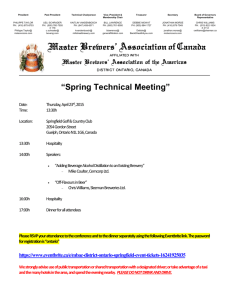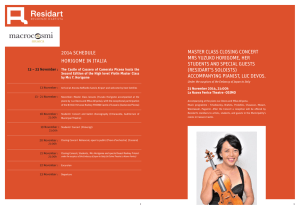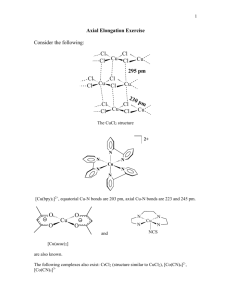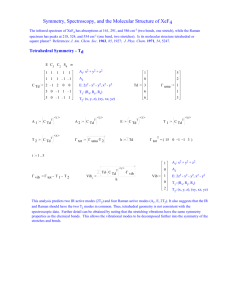BCD Arithmetic - Missouri University of Science and Technology
advertisement
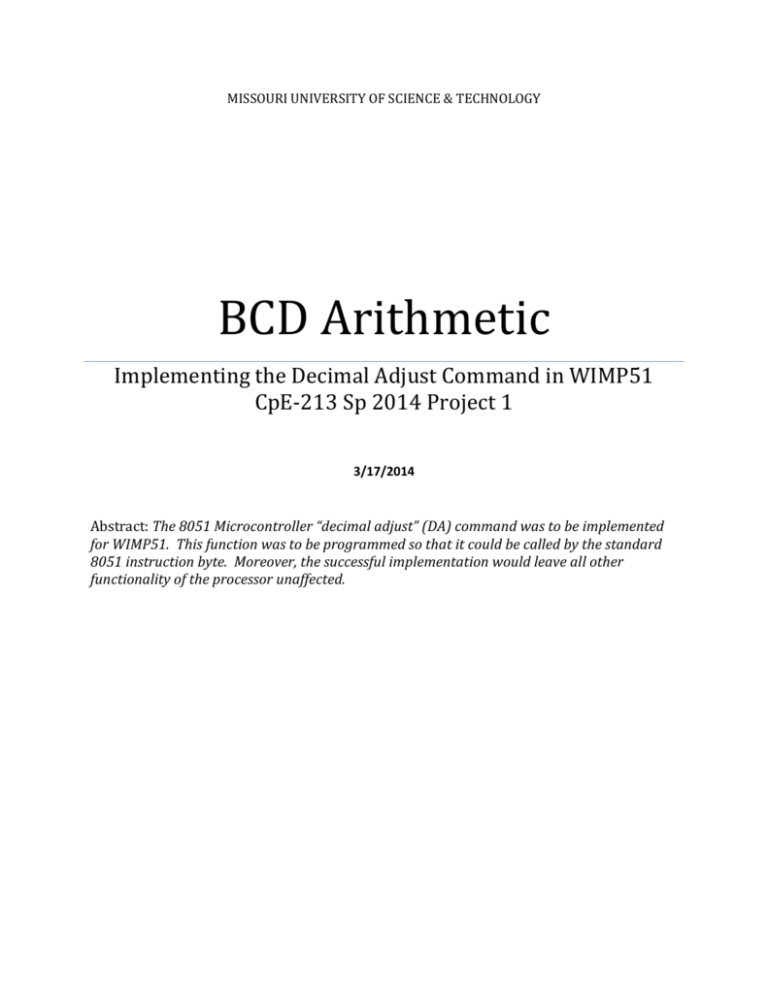
MISSOURI UNIVERSITY OF SCIENCE & TECHNOLOGY BCD Arithmetic Implementing the Decimal Adjust Command in WIMP51 CpE-213 Sp 2014 Project 1 3/17/2014 Abstract: The 8051 Microcontroller “decimal adjust” (DA) command was to be implemented for WIMP51. This function was to be programmed so that it could be called by the standard 8051 instruction byte. Moreover, the successful implementation would leave all other functionality of the processor unaffected. Table of Contents 2 Introduction 2 Description of Work 6 Conclusion 7 Appendix A—Test Program 1 Introduction The 8051 microcontroller has several functions not available in the WIMP51. One such function is “decimal adjust”, which converts single byte hexadecimal numbers to binarycoded decimal (BCD) and allows for decimal arithmetic to be performed on what are in fact binary numbers. The assembly level command for 8051’s decimal adjust is DA; and the machine code is D4H. For convenience, the 8051 instruction was retained in the WIMP51 implementation. Description of Work The majority of modifications to the WIMP51 affected only the arithmetic logic unit (ALU). The sole exception was the addition of inputs to the ALU from the least significant two bits of the instruction register (IR1 and IR0), in order to avoid possible conflicts between DA and SETB, since their instructions shared the same most significant four bits. (Time was not taken to determine whether there was actually a conflict here; but during troubleshooting, the extra inputs were added to reduce the number of possible sources of malfunction.) The algorithm for BCD was simple enough. When two numbers were added, the result was checked to ensure that neither the most significant nibble (MSN) nor the least significant nibble (LSN) was greater than 9H. If either nibble was greater than 9H, then 6H was added to that nibble in order to “correct” the result. Also, if the carry bit (CY) or the auxiliary carry bit (AC) was ‘1’, then 6H was to be added to the MSN or the LSN, respectively. The main change to the ALU consisted of inserting eight 4:1 MUX’s between the inputs from the auxiliary register (AUX_REG_n) and the B inputs of the 8-bit ripple adder (B_n). The aux register values were routed through inputs 00 and 10 of the corresponding MUX, these two inputs simply being jumpered together. Input 01 of each MUX was connected directly to ground. Inputs 11 were connected to logic 0 (ground) and 1 (VCC) in the following pattern: 0110 0110. The switching input S_0 on each MUX was connected to logic designed to return ‘1’ if and only if the instruction register contained D4H (1101 0100). And inputs S_1 corresponding to the MSN and the LSN of the auxiliary register were made to be ‘1’ whenever the carry bit and the auxiliary carry bit were ‘1’, respectively. With this configuration, the following five outputs were possible: Figure 1—BCD MUX Inputs and Outputs S1 (MSN) X 0 0 1 1 S1 (LSN) X 0 1 0 1 S0 0 1 1 1 1 MUX Outputs AUX_REG_7-0 0000 0000 0000 0110 0110 0000 0110 0110 2 The logic circuit designed to control the S_0 inputs was simply an eight-input AND gate with four NOT gates complimenting the values of IR5, IR3, IR1 and IR0, as shown in Figure 2, below. Thus the state of S_0 was ‘1’ only for the D4H instruction, as mentioned before. Figure 2—DA Instruction Decoding The auxiliary carry used to control the state of the S_1’s in the LSN did not already exist in the WIMP51, and therefore had to be created before DA could be implemented. This was done simply by tapping the internal carry bit from the fourth to the fifth adder in the ripple adder, as shown in Figure 3. It was also necessary to ensure that this AC bit would be latched during the whole DA cycle. To accomplish this, the 2:1 MUX and D flip-flop circuit that was already being used to hold the carry bit was duplicated for the AC. In both cases, the state of the bit would be held until a SETB or CLR instruction was received from the IR. 3 Figure 3—Auxiliary Carry 4 Figure 4—Latching of AC Bit Two additional modifications were found to be necessary before DA would function properly. First, the MSN of the DA instruction (DH or 1101) had to be added as a condition for accumulator write-enable in the L_A_Select object (see Figure 5). And second, the carry bit being held in the aforementioned latch had to be blocked from the ripple adder carry-in during the DA operation. This was necessary, because one of the conditions for DA adding 0110 to the MSN is if CY is 1. But if CY is passed into the adder carry-in in this case, then 0111 would be added to the MSN instead of 0110—‘7’ instead of ‘6’. Figure 6 shows the 2:1 MUX inserted in the path of the CY/carry-in to block it during DA. 5 Figure 5—LA Select Figure 6—Block Carry-in for DA Finally, the DA instruction, as well as the entire standard WIMP51 instruction set, was tested to ensure that everything was working properly. The test code used can be found in Appendix A. Lines 00-1B of this program demonstrate the functionality of the DA instruction, and line 1B-38 make us of all of the other instructions. Conclusion As mentioned above, the problem seemed simple enough—the problem of how to implement BCD arithmetic in WIMP51. Still, some trial and error proved necessary before a fully functioning solution was found. However, such unforeseen difficulties cannot help but further the learning process. 6 Appendix A—Test Program 00 01 02 03 04 05 06 07 08 09 0A 0B 0C 0D 0E 0F 10 11 12 13 14 15 16 17 18 19 1A 1B 1C 1D 1E 1F 20 21 22 23 24 25 26 27 28 29 2A Code CLR C MOV A, #00H ADDC A, #0AH DA A ADDC A, #F0H DA A CLR C ADDC A, #60 DA A CLR C SWAP A ADDC A, #0F DA A CLR C ADDC A, #FB DA A CLR C ADDC A, #44 DA A CLR C DA A MOV A, #05H ADDC A, #07H MOV R7, A ADDC A, R7 SWAP A MOV A, R7 XRL A, R7 ORL A, R7 SWAP A ADDC A, R7 ANL A, R7 SETB C CLR C Accumulator 00H 00H 00H 00H 00H 0AH 10H 10H 00H 60H 60H 60H C0H 20H 20H 02H 02H 11H 17H 17H 17H 12H 78H 78H 78H BCH 22H 22H 22H 22H 05H 05H 0CH 0CH 18H 81H 0CH 00H 0CH C0H CCH 0CH 0CH C3H 74H 00H 34H 0AH D4H 34H F0H D4H C3H 34H 60H D4H C3H C4H 34H 0FH D4H C3H 34H FBH D4H C3H 34H 44H D4H C3H D4H 74H 05H 34H 07H FFH 3FH C4H EFH 6FH 4FH C4H 3FH 5FH D3H C3H 7 Notes LSN>9 C=1 MSN>9 AC=1 C=AC=1 MSN, LSN>9 MSN, LSN<9, C=AC=0 2B C2 2D 2E 2F 30 31 32 33 34 35 36 37 38 MOV A, #04H X: CLR C ADDC A, #FFH JZ Y SJMP X Y: SETB C ADDC A, #02H Z: SJMP Z 74H 04H C3H 34H FFH 60H 02H 80H F9H D3H 34H 02H 80H FEH 0CH 0CH 04H 04H 04H 03H,02H,01H,00H 00H 00H 00H 03H 03H 8
